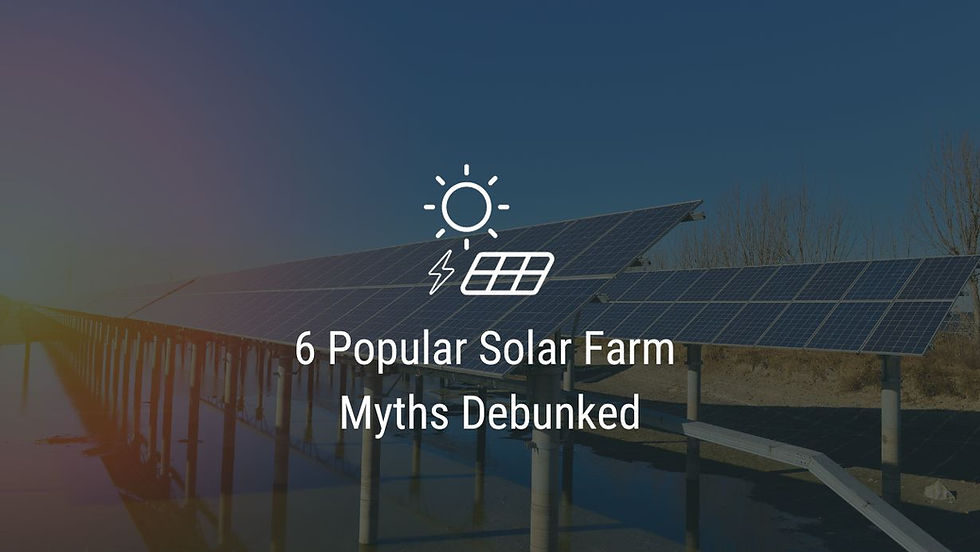
Solar energy leases are a great way for landowners to make money from their property. As renewable energy becomes increasingly incentivized, energy developers are willing to invest more in renewable interests and will continue planning new projects across the United States.
So why doesn’t every landowner jump on such an opportunity? With popularity comes myths and misconceptions. There are a multitude of these blowing around about solar panels that could hinder plans to lease your land for solar energy. Here, we’ll address some of the most common misconceptions.
Key Takeaways:
Long-term Investment: Solar farms are not temporary; they are a cost-effective, long-term solution for renewable energy, expected to become the largest electricity source by 2035.
Minimal Land Impact: Modern solar technology minimizes land disturbance, and developers restore land post-lease. Solar farms can even increase property values.
Space Efficiency: Solar panels can be installed on various surfaces, not just large land areas, including rooftops and water surfaces.
Weather Resilience: Solar panels function in cloudy and cold climates, with technology designed to capture sunlight efficiently in less-than-ideal conditions.
Farmland Preservation: The use of farmland for solar projects has decreased due to technological advances and increased agricultural productivity.
Health Safety: Solar farms pose no health risks, as electromagnetic fields generated are similar to household appliances and dissipate with distance.
Myth #1: Solar Farms are a Temporary Solution
Many people believe that solar farms are simply a temporary solution to our energy needs and will eventually be replaced by other renewable technologies. This is not the case, as solar energy is increasingly becoming the most cost-effective and efficient form of renewable energy. In fact, according to the International Energy Agency, solar power is set to become the largest source of electricity by 2035. Solar farms are a long-term investment that will continue to provide clean energy for decades to come.
Myth #2: Solar Panels Will Damage Your Land
Some landowners worry about the potential damage to their land caused by solar panels and believe it will negatively impact their property value. However, modern solar technology is designed to minimize any impact on the land. Solar panels are mounted
on racks, which are secured to the ground with minimal disturbance to the soil.
Although solar panels can hinder what you can do with your land during a solar lease agreement, solar developers are responsible for restoring the property to its original condition after the lease agreement expires. Additionally, solar farms can increase property values as they provide a steady source of income for landowners.
Myth #3: Solar Farms Take Up Too Much Space
One of the most common misconceptions about solar farms is that they require a large amount of land. This is not necessarily true, as solar panels can be installed on a variety of different surfaces such as rooftops, parking lots, and even water surfaces.
Myth #4: Solar Panels are Not Efficient in Cloudy or Cold Climates
Contrary to popular belief, solar panels can still generate electricity on cloudy and cold days. While they do not produce as much energy as they would on a sunny day (anything that blocks sunlight from reaching solar panels affects their power production), modern solar technology is designed to capture the sun's rays even in less-than-ideal weather conditions. Similarly, temperature does not affect how much energy a solar panel receives, but it does impact how much power that energy can produce. Some states that aren't known for their warm climates are especially popular for solar farming, such as Minnesota.
Myth #5: Solar Farms are Making Farmland Disappear
Many individuals express concerns about the disappearance of farmland in the United States due to urbanization and industrialization. They argue that solar farms, in particular, are occupying land that could otherwise be used for agriculture. While it is true that solar farms do require land for the solar panels to be placed on, it is important to note that the amount of farmland being utilized for solar projects has decreased compared to previous years. This is attributed to the advances in solar panel technology along with the increased productivity of farmers, who are now able to generate higher crop yields with fewer acres.
Myth #6: Solar Farms Have Health Implications
Solar facilities generate electromagnetic fields similar to household appliances within close proximity, which dissipate as distance increases. According to the U.S. Department of Energy, this poses no health risk to adults or children.
How to Get a Solar Farm on Your Land
Leasing your land for a solar farm is a great way to earn income from your land through solar lease payments and support clean energy production. LandGate has already calculated a solar lease estimate for every parcel of land in the U.S. — and we’re ready to share that data with you for free!
Skip the guesswork and get your free Property Report to get your Solar LandEstimate™. If you like what you see – you can create a listing on LandGate's online marketplace to explore offers from hundreds of solar energy investors that are actively planning new projects: